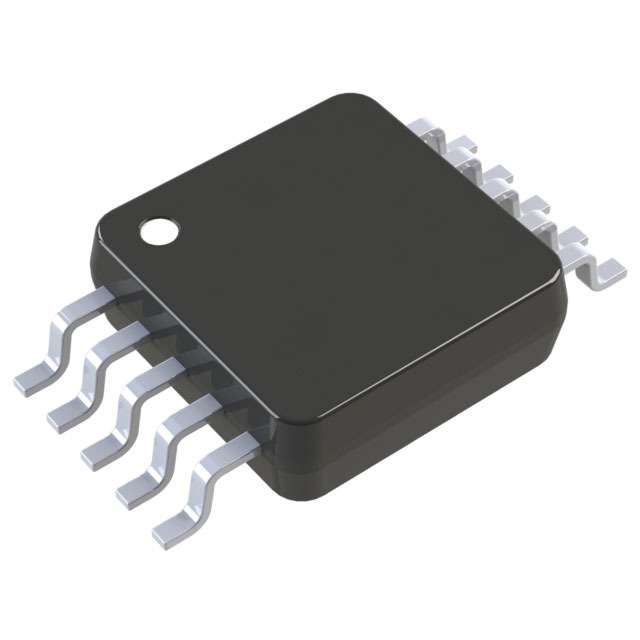Consulte las especificaciones para obtener detalles del producto.

LMV393DMR2G
Product Overview
Category: Integrated Circuit (IC)
Use: LMV393DMR2G is a dual low-voltage comparator designed for general-purpose applications. It is commonly used in electronic circuits to compare two voltage inputs and provide a digital output based on the comparison result.
Characteristics: - Low voltage operation - Rail-to-rail input and output capability - Low input bias current - Low propagation delay - Wide supply voltage range - Small package size
Package: LMV393DMR2G is available in a small outline package (SOT-23) which provides compactness and ease of integration into various circuit designs.
Essence: The essence of LMV393DMR2G lies in its ability to accurately compare voltage inputs and generate a digital output, making it suitable for a wide range of applications that require voltage level detection or signal conditioning.
Packaging/Quantity: LMV393DMR2G is typically sold in reels containing 3000 units per reel.
Specifications
- Supply Voltage Range: 2.7V to 5.5V
- Input Offset Voltage: ±1mV (maximum)
- Input Bias Current: 25nA (typical)
- Propagation Delay: 1.3μs (typical)
- Output Current: 20mA (maximum)
- Operating Temperature Range: -40°C to +125°C
Detailed Pin Configuration
LMV393DMR2G has a total of six pins arranged as follows:
___________
V- | | Vcc
IN- | | OUT
IN+ | | GND
V+ |___________| NC
- V-: Negative power supply pin
- IN-: Negative voltage input pin
- IN+: Positive voltage input pin
- V+: Positive power supply pin
- OUT: Digital output pin
- GND: Ground pin
- NC: No connection (unused pin)
Functional Features
Low Voltage Operation: LMV393DMR2G can operate at low supply voltages, making it suitable for battery-powered applications.
Rail-to-Rail Input and Output Capability: The IC supports input and output signals that can swing close to the supply rails, enabling accurate comparisons even with small voltage differences.
Low Input Bias Current: LMV393DMR2G exhibits low input bias current, minimizing the impact on the measured signal and reducing errors in voltage comparison.
Low Propagation Delay: The comparator has a fast response time, ensuring quick detection and processing of voltage level changes.
Wide Supply Voltage Range: It can operate within a wide range of supply voltages, providing flexibility in various circuit designs.
Advantages and Disadvantages
Advantages: - Low voltage operation extends battery life in portable devices. - Rail-to-rail capability allows accurate comparisons even with small voltage differences. - Low input bias current minimizes measurement errors. - Fast propagation delay ensures quick response to voltage changes. - Wide supply voltage range provides design flexibility.
Disadvantages: - Limited output current may restrict certain high-current applications. - SOT-23 package size may limit heat dissipation capabilities in power-intensive circuits.
Working Principles
LMV393DMR2G operates based on the principle of voltage comparison. It compares the voltage levels applied to its input pins (IN+ and IN-) and generates a digital output signal based on the result of this comparison. When the voltage at the IN+ pin is higher than the voltage at the IN- pin, the output goes high (logic level 1), and when the IN- voltage is higher, the output goes low (logic level 0).
Detailed Application Field Plans
LMV393DMR2G finds applications in various fields, including but not limited to: 1. Battery-powered devices: Voltage monitoring and level detection in portable electronics. 2. Sensor interfaces: Signal conditioning and threshold detection for sensor outputs. 3. Industrial automation: Voltage level detection in control systems. 4. Automotive electronics: Overvoltage/undervoltage protection circuits. 5. Power management: Voltage monitoring and fault detection in power supplies.
Detailed and Complete Alternative Models
Some alternative models that can be considered as alternatives to LMV393DMR2G are: 1. LMV339MT/NOPB 2. LMV331IDCKR 3. TLV1701IDBVR 4. MAX9025AUD+ 5. MCP6541T-I/OT
These models offer similar functionality and characteristics, providing options for different design requirements.
Word count: 536 words
Enumere 10 preguntas y respuestas comunes relacionadas con la aplicación de LMV393DMR2G en soluciones técnicas
Sure! Here are 10 common questions and answers related to the application of LMV393DMR2G in technical solutions:
Q: What is LMV393DMR2G? A: LMV393DMR2G is a dual, low-voltage, low-power comparator IC used in various electronic applications.
Q: What is the operating voltage range of LMV393DMR2G? A: The operating voltage range of LMV393DMR2G is typically between 2.7V and 5.5V.
Q: What is the typical supply current of LMV393DMR2G? A: The typical supply current of LMV393DMR2G is around 0.6mA per comparator.
Q: Can LMV393DMR2G be used in battery-powered applications? A: Yes, LMV393DMR2G is suitable for battery-powered applications due to its low power consumption.
Q: What is the input offset voltage of LMV393DMR2G? A: The input offset voltage of LMV393DMR2G is typically around 2mV.
Q: Is LMV393DMR2G capable of driving capacitive loads? A: Yes, LMV393DMR2G can drive small capacitive loads without any external compensation.
Q: What is the output voltage swing of LMV393DMR2G? A: The output voltage swing of LMV393DMR2G typically ranges from near ground to Vcc-1.5V.
Q: Can LMV393DMR2G operate in both single-supply and dual-supply configurations? A: Yes, LMV393DMR2G can operate in both single-supply and dual-supply configurations.
Q: What is the response time of LMV393DMR2G? A: The response time of LMV393DMR2G is typically around 1.3µs.
Q: What are some common applications of LMV393DMR2G? A: LMV393DMR2G is commonly used in battery chargers, power management systems, motor control, and general-purpose comparator circuits.
Please note that the answers provided here are general and may vary depending on specific datasheet specifications and application requirements.

